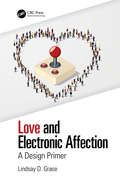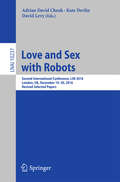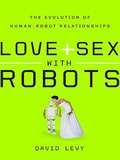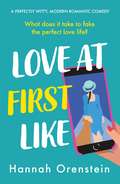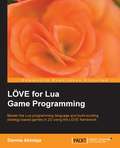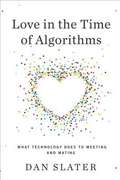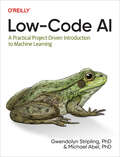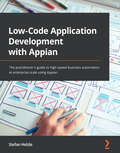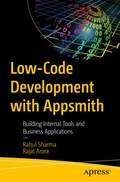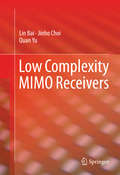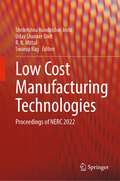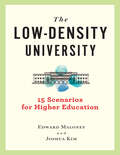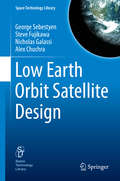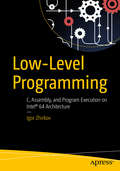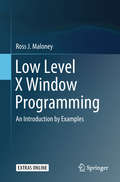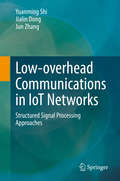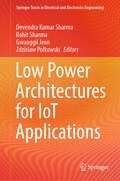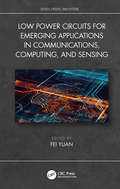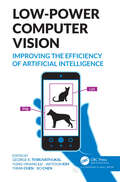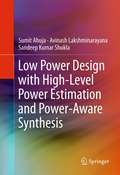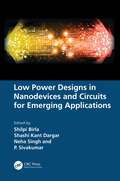- Table View
- List View
Love and Electronic Affection: A Design Primer
by Lindsay D. GraceLove and Electronic Affection: A Design Primer brings together thought leadership in romance and affection games to explain the past, present, and possible future of affection play in games. The authors apply a combination of game analysis and design experience in affection play for both digital and analog games. The research and recommendations are intersectional in nature, considering how love and affection in games is a product of both player and designer age, race, class, gender, and more. The book combines game studies with game design to offer a foundation for incorporating affection into playable experiences. The text is organized into two sections. The first section covers the patterns and practice of love and affection in games, explaining the patterns and practice. The second section offers case studies from which designers can learn through example. Love and Electronic Affection: A Design Primer is a resource for exploring how digital relationships are offered and how to convey emotion and depth in a variety of virtual worlds. This book provides: • A catalog of existing digital and analog games for which love and affection are a primary or secondary focus. • A catalog of the uses of affection in games, to add depth and investment in both human-computer and player-to-player engagement. • Perspective on affection game analyses and design, using case studies that consider the relationship of culture and affection as portrayed in games from large scale studios to single author independent games. • Analysis and design recommendations for incorporating affection in games beyond romance, toward parental love, affection between friends, and other relationships. • Analysis of the moral and philosophical considerations for historical and planned development of love and affection in human–computer interaction. • An intersectionality informed set of scholarly perspectives from the Americas, Eurasia, and Oceania. Editor Bio: Lindsay D. Grace is Knight Chair of Interactive Media and an Associate Professor at the University of Miami School of Communication. He is Vice President for the Higher Education Video Game Alliance and the 2019 recipient of the Games for Change Vanguard award. Lindsay is author of Doing Things with Games, Social Impact through Design and more than fifty peer-reviewed papers on games and related research. He has given talks at the Game Developers Conference, SXSW, Games for Change Festival, the Online News Association, the Society for News Design, and many other industry events. He was the founding director of the American University Game Lab and Studio and the designer-developer behind several award winning games, including two affection games. He served as Vice President and on the board of directors for the Global Game Jam™ non-profit between 2014 and 2019. From 2009 to 2013 he was the Armstrong Professor at Miami University’s School of Art. Lindsay also served on the board for the Digital Games Research Association (DiGRA) between 2013 and 2015.
Love and Sex with Robots
by Adrian David Cheok Kate Devlin David LevyLove, marriage, and sex with robots? Not in a million years? Maybe a whole lot sooner! A leading expert in artificial intelligence, David Levy argues that the entities we once deemed cold and mechanical will soon become the objects of real companionship and human desire. He shows how automata have evolved and how human interactions with technology have changed over the years. Levy explores many aspects of human relationships—the reasons we fall in love, why we form emotional attachments to animals and virtual pets, and why these same attachments could extend to love for robots. Levy also examines how society's ideas about what constitutes normal sex have changed—and will continue to change—as sexual technology becomes increasingly sophisticated. Shocking, eye-opening, provocative, and utterly convincing, Love and Sex with Robots is compelling reading for anyone with an open mind.
Love and Sex with Robots
by David LevyLove, marriage, and sex with robots? Not in a million years? Maybe a whole lot sooner! A leading expert in artificial intelligence, David Levy argues that the entities we once deemed cold and mechanical will soon become the objects of real companionship and human desire. He shows how automata have evolved and how human interactions with technology have changed over the years. Levy explores many aspects of human relationships--the reasons we fall in love, why we form emotional attachments to animals and virtual pets, and why these same attachments could extend to love for robots. Levy also examines how society's ideas about what constitutes normal sex have changed--and will continue to change--as sexual technology becomes increasingly sophisticated. Shocking, eye-opening, provocative, and utterly convincing, Love and Sex with Robots is compelling reading for anyone with an open mind.
Love at First Like: A wise and witty rom-com of love in the digital age
by Hannah OrensteinIf you love Jo Watson, Zara Stoneley and Sophie Ranald, you'll LOVE Hannah Orenstein!'A good read for the holidays (or lockdown)' 5* reader review*Includes a special preview of Head Over Heels, Hannah's glorious new rom-com that will make you CHEER!*Love at First Like is the perfect rom-com for anyone who's ever looked for love online!'Such a perfect book for this digital age' 5* reader review'The perfect vacation read!' 5* reader review'I inhaled this book' 5* reader reviewWHAT DOES IT TAKE TO FAKE THE PERFECT LOVE LIFE?Eliza Roth and her sister Sophie co-own a jewelry shop in Brooklyn. One night, after learning of an ex's engagement, Eliza accidentally posts a photo of herself wearing a diamond ring on that finger to her Instagram account beloved by 100,000 followers. Sales skyrocket, press rolls in, and Eliza learns that her personal life is good for business. So she has a choice: continue the ruse or clear up the misunderstanding. With mounting financial pressure, Eliza sets off to find a fake fiancé.Fellow entrepreneur Blake seems like the perfect match on paper, and in real life he shows promise too - if only Eliza didn't feel also drawn to someone else. But Blake doesn't know Eliza is 'engaged'; Sophie asks Eliza for an impossible sum of money; and Eliza's lies start to spiral out of control. Now she can either stay engaged online - or fall in love in real life.Written with singular charm and style, Love at First Like is for anyone growing up and settling down in the digital age.'This glittering gem of a novel is a wise and witty take on family, ambition, and modern love' Andrea Dunlop, author of We Came to Forget
Love, Decoded
by Jennifer YenA hilarious, heartfelt rom-com about the unexpected consequences of one teen's quest to help her friends find love, perfect for fans of Jenny Han and Jane Austen. <p><p> High school junior Gigi Wong strives to be the best. After all, that’s what everyone expects of her—her parents, friends, and even potential colleges. Thankfully, her best friend, Kyle, is always there to listen with a smile and a delicious bowl of ramen. Still, with her future—and her dreams—on the line, how is she to stand out when her classmates seem so perfect too? Her answer comes in the form of an app writing contest. If Gigi can secure the nomination to represent her school, she has a chance at a prestigious tech internship. That’s sure to get her applications noticed . . . All she needs is a winning entry. <p><p> When transfer student and new friend Etta confides that she’s struggling to fit in, it gives Gigi an idea. What if she takes what she’s learned from shadowing her aunt Rose, a professional matchmaker, to create a fun friend-making app? Perfect! When Gigi's app goes viral at school, she's the center of attention--and a major scandal. She never meant to hurt anyone, let alone Etta and Kyle. Can she save all she worked so hard for and the relationships that mean so much to her?
LÖVE for Lua Game Programming
by Darmie AkinlajaThis book follows a tutorial approach with examples and step-by-step instructions to help explain the key concepts of the LÖVE framework as well as everything you need to know about game development using the Lua programming language.LÖVE2d for Lua Game Programming is for anyone who is interested in learning about desktop game development.
Love in the Time of Algorithms
by Dan Slater“If online dating can blunt the emotional pain of separation, if adults can afford to be increasingly demanding about what they want from a relationship, the effect of online dating seems positive. But what if it’s also the case that the prospect of finding an ever more compatible mate with the click of a mouse means a future of relationship instability, a paradox of choice that keeps us chasing the illusive bunny around the dating track?” It’s the mother of all search problems: how to find a spouse, a mate, a date. The escalating marriage age and declining marriage rate mean we’re spending a greater portion of our lives unattached, searching for love well into our thirties and forties. It’s no wonder that a third of America’s 90 million singles are turning to dating Web sites. Once considered the realm of the lonely and desperate, sites like eHarmony, Match, OkCupid, and Plenty of Fish have been embraced by pretty much every demographic. Thanks to the increasingly efficient algorithms that power these sites, dating has been transformed from a daunting transaction based on scarcity to one in which the possibilities are almost endless. Now anyone—young, old, straight, gay, and even married—can search for exactly what they want, connect with more people, and get more information about those people than ever before. As journalist Dan Slater shows, online dating is changing society in more profound ways than we imagine. He explores how these new technologies, by altering our perception of what’s possible, are reconditioning our feelings about commitment and challenging the traditional paradigm of adult life. Like the sexual revolution of the 1960s and ’70s, the digital revolution is forcing us to ask new questions about what constitutes “normal”: Why should we settle for someone who falls short of our expectations if there are thousands of other options just a click away? Can commitment thrive in a world of unlimited choice? Can chemistry really be quantified by math geeks? As one of Slater’s subjects wonders, “What’s the etiquette here?” Blending history, psychology, and interviews with site creators and users, Slater takes readers behind the scenes of a fascinating business. Dating sites capitalize on our quest for love, but how do their creators’ ideas about profits, morality, and the nature of desire shape the virtual worlds they’ve created for us? Should we trust an industry whose revenue model benefits from our avoiding monogamy? Documenting the untold story of the online-dating industry’s rise from ignominy to ubiquity—beginning with its early days as “computer dating” at Harvard in 1965—Slater offers a lively, entertaining, and thought provoking account of how we have, for better and worse, embraced technology in the most intimate aspect of our lives. .
Love in the Time of Algorithms
by Dan Slater"If online dating can blunt the emotional pain of separation, if adults can afford to be increasingly demanding about what they want from a relationship, the effect of online dating seems positive. But what if it's also the case that the prospect of finding an ever more compatible mate with the click of a mouse means a future of relationship instability, a paradox of choice that keeps us chasing the illusive bunny around the dating track?" It's the mother of all search problems: how to find a spouse, a mate, a date. The escalating marriage age and declining marriage rate mean we're spending a greater portion of our lives unattached, searching for love well into our thirties and forties. It's no wonder that a third of America's 90 million singles are turning to dating Web sites. Once considered the realm of the lonely and desperate, sites like eHarmony, Match, OkCupid, and Plenty of Fish have been embraced by pretty much every demographic. Thanks to the increasingly efficient algorithms that power these sites, dating has been transformed from a daunting transaction based on scarcity to one in which the possibilities are almost endless. Now anyone--young, old, straight, gay, and even married--can search for exactly what they want, connect with more people, and get more information about those people than ever before. As journalist Dan Slater shows, online dating is changing society in more profound ways than we imagine. He explores how these new technologies, by altering our perception of what's possible, are reconditioning our feelings about commitment and challenging the traditional paradigm of adult life. Like the sexual revolution of the 1960s and '70s, the digital revolution is forcing us to ask new questions about what constitutes "normal": Why should we settle for someone who falls short of our expectations if there are thousands of other options just a click away? Can commitment thrive in a world of unlimited choice? Can chemistry really be quantified by math geeks? As one of Slater's subjects wonders, "What's the etiquette here?" Blending history, psychology, and interviews with site creators and users, Slater takes readers behind the scenes of a fascinating business. Dating sites capitalize on our quest for love, but how do their creators' ideas about profits, morality, and the nature of desire shape the virtual worlds they've created for us? Should we trust an industry whose revenue model benefits from our avoiding monogamy? Documenting the untold story of the online-dating industry's rise from ignominy to ubiquity--beginning with its early days as "computer dating" at Harvard in 1965--Slater offers a lively, entertaining, and thought provoking account of how we have, for better and worse, embraced technology in the most intimate aspect of our lives.
Love, IRL (Lorimer Real Love)
by Tracy GoldfarbAlex, a Latino transgender teen, is struggling to balance his feelings for a real-life crush on a Jewish boy in his class and the relationship he has with a boy he knows online—only to find that the two were the same all along. Although not explicit, important issues youth face surrounding online chat rooms, social media, and sexting are brought to light in this refreshing take on an LGTBQ+ relationship. Themes of secret identities and love letters together in a modern LGBTQ+ romance for the digital age make this an exciting and relevant read for teens. Distributed in the U.S by Lerner Publishing Group
Low-Code AI
by Gwendolyn Stripling Michael AbelTake a data-first and use-case–driven approach with Low-Code AI to understand machine learning and deep learning concepts. This hands-on guide presents three problem-focused ways to learn no-code ML using AutoML, low-code using BigQuery ML, and custom code using scikit-learn and Keras. In each case, you'll learn key ML concepts by using real-world datasets with realistic problems.Business and data analysts get a project-based introduction to ML/AI using a detailed, data-driven approach: loading and analyzing data; feeding data into an ML model; building, training, and testing; and deploying the model into production. Authors Michael Abel and Gwendolyn Stripling show you how to build machine learning models for retail, healthcare, financial services, energy, and telecommunications.You'll learn how to:Distinguish between structured and unstructured data and the challenges they presentVisualize and analyze dataPreprocess data for input into a machine learning modelDifferentiate between the regression and classification supervised learning modelsCompare different ML model types and architectures, from no code to low code to custom trainingDesign, implement, and tune ML modelsExport data to a GitHub repository for data management and governance
Low-Code Application Development with Appian: The practitioner's guide to high-speed business automation at enterprise scale using Appian
by Stefan HelzleGo from no-code to low-code and translate your business requirements into full-fledged enterprise-ready applicationsKey FeaturesDigitize and automate your business processes quickly using Appian's powerful low-code functionalitiesUnderstand enterprise data models and turn them into actionable Appian RecordsUse declarative code-style UI building to design intuitive UIs and reusable components in AppianBook DescriptionThis book is an exhaustive overview of how the Appian Low-Code BPM Suite enables tech-savvy professionals to rapidly automate business processes across their organization, integrating people, software bots, and data. This is crucial as 80% of all software development is expected to be carried out in low code by 2024. This practical guide helps you master business application development with Appian as a beginner low-code developer. You'll learn to automate business processes using Appian low-code, records, processes, and expressions quickly and on an enterprise scale. In a fictional development project, guided by step-by-step explanations of the concepts and practical examples, this book will empower you to transform complex business processes into software. At first, you'll learn the power of no-code with Appian Quick Apps to solve some of your most crucial business challenges. You'll then get to grips with the building blocks of an Appian, starting with no-code and advancing to low-code, eventually transforming complex business requirements into a working enterprise-ready application. By the end of this book, you'll be able to deploy Appian Quick Apps in minutes and successfully transform a complex business process into low-code process models, data, and UIs to deploy full-featured, enterprise-ready, process-driven, mobile-enabled apps.What you will learnUse Appian Quick Apps to solve the most urgent business challengesLeverage Appian's low-code functionalities to enable faster digital innovation in your organizationModel business data, Appian records, and processesPerform UX discovery and UI building in AppianConnect to other systems with Appian Integrations and Web APIsWork with Appian expressions, data querying, and constantsWho this book is forThis book empowers software developers and tech-savvy business users with a new tool that'll help them increase efficiency by a huge margin and speed up the delivery of new features to meet the demands of business departments. Business users with a maker's attitude finally have the chance to develop their own business applications, as low-code drastically reduces the complexity of traditional software development. Prior experience with automation solutions and low-code programming is needed to help you get the most out of this book.
Low-Code Development with Appsmith: Building Internal Tools and Business Applications
by Rahul Sharma Rajat AroraThis book will show you how to harness the power of Appsmith, an open-source low-code platform with a large set of integration tools and an active community. The book begins with an introduction to Appsmith and its features. As you explore the platform, you will learn about widgets, UI Canvas, and data stores, among other things. Authors Rahul Sharma and Rajat Arora then show you how to build customizations and navigation workflows, as well as how to handle error handling, debugging, and troubleshooting with Appsmith. You will also learn efficient monitoring and authentication for deploying production-ready systems. Low-Code Development with AppSmith provides examples, realistic scenarios, and explanations of the tools you'll need to build successful low-code apps, helping you gain practical skills. Upon completing this book, you will be able to use Appsmith to build low-code solutions that suit your business requirements. What You Will Learn Understand low-code development and the factors driving its adoptionSolve your business's most pressing issues with AppsmithGain an understanding of the key concepts of app development, such as data management, APIs, troubleshooting, and debuggingModel different design patterns for low-code development Who This Book Is For Anyone interested in designing technical solutions with minimal programming. This book assumes a basic understanding of object-oriented programming and JavaScript.
Low Complexity MIMO Receivers
by Lin Bai Jinho Choi Quan YuMultiple-input multiple-output (MIMO) systems can increase the spectral efficiency in wireless communications. However, the interference becomes the major drawback that leads to high computational complexity at both transmitter and receiver. In particular, the complexity of MIMO receivers can be prohibitively high. As an efficient mathematical tool to devise low complexity approaches that mitigate the interference in MIMO systems, lattice reduction (LR) has been widely studied and employed over the last decade. The co-authors of this book are world's leading experts on MIMO receivers, and here they share the key findings of their research over years. They detail a range of key techniques for receiver design as multiple transmitted and received signals are available. The authors first introduce the principle of signal detection and the LR in mathematical aspects. They then move on to discuss the use of LR in low complexity MIMO receiver design with respect to different aspects, including uncoded MIMO detection, MIMO iterative receivers, receivers in multiuser scenarios, and multicell MIMO systems.
Low Cost Manufacturing Technologies: Proceedings of NERC 2022
by Shrikrishna Nandkishor Joshi Uday Shanker Dixit R. K. Mittal Swarup BagThis book is on various advanced, simple, and novel techniques being used and developed in the area of manufacturing processes. Manufacturing sector is one of the important areas which help to improve the economy of our nation. It not only generates employment opportunities but also makes us self-reliant (aatma nirbhar). In line with this important agenda of Government of India, this track envisages high-quality research contributions in the field of low-cost manufacturing technologies. It comprises the research and development studies on the various factors that influence the cost of manufacturing of product or system. The factors are materials, manufacturing processes, material handling processes, skilled manpower, quality control technologies, effective communication, and use of artificial intelligence techniques. The papers are on both numerical and experimental research works related to these aspects.
The Low-Density University: 15 Scenarios for Higher Education
by Edward J. Maloney Joshua KimCOVID-19 has placed American higher education at a crossroads. This book is the roadmap.COVID-19 triggered an existential crisis for American higher education. Faced with few safe choices, most colleges and universities switched to remote learning during the 2020 spring semester. The future, however, provides more choices about how institutions can fulfill their mission of teaching and research. But how do we begin to make decisions in an uncertain and shifting environment? In this concise guide, authors Edward J. Maloney and Joshua Kim lay out clear ways colleges and universities can move forward in safe and effective ways.The Low-Density University presents fifteen scenarios for how colleges and universities can address the current crisis from a fully online semester to others with students in residence and in the classroom. How can changing the calendar or shifting to hybrid models of blended classrooms impact teaching, learning, and the college experience? Could we emerge from this crisis with new models that are better and more adapted to today's world? The Low-Density University focuses primarily on teaching and learning, but student life (housing, athletics, health, etc.) are core to the college experience. Can we devise safe and effective ways to preserve the best of that experience? The lessons here extend beyond the classroom. Just as the pandemic will change American higher education, the choices we make now will change what college looks like for generations to come.
Low Earth Orbit Satellite Design
by George Sebestyen Steve Fujikawa Nicholas Galassi Alex ChuchraIn recent decades, the number of satellites being built and launched into Earth’s orbit has grown immensely, alongside the field of space engineering itself. This book offers an in-depth guide to engineers and professionals seeking to understand the technologies behind Low Earth Orbit satellites.With access to special spreadsheets that provide the key equations and relationships needed for mastering spacecraft design, this book gives the growing crop of space engineers and professionals the tools and resources they need to prepare their own LEO satellite designs, which is especially useful for designers of small satellites such as those launched by universities. Each chapter breaks down the various mathematics and principles underlying current spacecraft software and hardware designs.
Low-Level Programming
by Igor ZhirkovLearn Intel 64 assembly language and architecture, become proficient in C, and understand how the programs are compiled and executed down to machine instructions, enabling you to write robust, high-performance code. Low-Level Programming explains Intel 64 architecture as the result of von Neumann architecture evolution. The book teaches the latest version of the C language (C11) and assembly language from scratch. It covers the entire path from source code to program execution, including generation of ELF object files, and static and dynamic linking. Code examples and exercises are included along with the best code practices. Optimization capabilities and limits of modern compilers are examined, enabling you to balance between program readability and performance. The use of various performance-gain techniques is demonstrated, such as SSE instructions and pre-fetching. Relevant Computer Science topics such as models of computation and formal grammars are addressed, and their practical value explained. What You'll Learn Low-Level Programming teaches programmers to: Freely write in assembly language Understand the programming model of Intel 64 Write maintainable and robust code in C11 Follow the compilation process and decipher assembly listings Debug errors in compiled assembly code Use appropriate models of computation to greatly reduce program complexity Write performance-critical code Comprehend the impact of a weak memory model in multi-threaded applications Who This Book Is For Intermediate to advanced programmers and programming students
Low Level X Window Programming: An Introduction By Examples
by Ross J. MaloneyThis is the missing X Window book. While others have shown what the X Window system has available, this book shows how to convert this potential into working tools to fulfil your visualisation needs. It is of the show-me class of books. The majority of the book covers Xlib, although a short coverage of Xcb is also given. Included are: . The relationship between Xlib and the X Window protocol; . All the basic Xlib topics are covered; . Complete working programs with their results; . Exercises to reinforce the material just covered. A 9 part partition to building a complete X program is used throughout. This partitioning fosters the inclusion of all code necessary. All programs are written in C and are one to four pages in length. Open source programs with the occasional Postscript script are shown to provide support as needed. Throughout the examples consideration is given to using colour. The examples produce simple results with the aim of providing building blocks for application oriented codes. The book is directed at graduate students and researchers who create computer code to visualise their data.
The Low Light Photography Field Guide: Go Beyond Daylight To Capture Stunning Low Light Images (Field Guide Ser.)
by Michael FreemanLike all the titles in this successful series, The Low Light Photography Field Guide offers advice from a respected expert and professional. In this volume, Michael Freeman looks at an area that remains problematic for photographers with even top-of-the range equipment: low light.Opening with a section on the qualities of different kinds of low light, the book then deals with ways of overcoming gloomy situations, whether you're shooting hand-held or on a tripod. Post-production fixes are also covered, allowing the reader to turn difficult shots into amazing images.
Low-overhead Communications in IoT Networks: Structured Signal Processing Approaches
by Jun Zhang Yuanming Shi Jialin DongThe recent developments in wireless communications, networking, and embedded systems have driven various innovative Internet of Things (IoT) applications, e.g., smart cities, mobile healthcare, autonomous driving and drones. A common feature of these applications is the stringent requirements for low-latency communications. Considering the typical small payload size of IoT applications, it is of critical importance to reduce the size of the overhead message, e.g., identification information, pilot symbols for channel estimation, and control data. Such low-overhead communications also help to improve the energy efficiency of IoT devices. Recently, structured signal processing techniques have been introduced and developed to reduce the overheads for key design problems in IoT networks, such as channel estimation, device identification, and message decoding. By utilizing underlying system structures, including sparsity and low rank, these methods can achieve significant performance gains.This book provides an overview of four general structured signal processing models: a sparse linear model, a blind demixing model, a sparse blind demixing model, and a shuffled linear model, and discusses their applications in enabling low-overhead communications in IoT networks. Further, it presents practical algorithms based on both convex and nonconvex optimization approaches, as well as theoretical analyses that use various mathematical tools.
Low Power Architectures for IoT Applications (Springer Tracts in Electrical and Electronics Engineering)
by Devendra Kumar Sharma Rohit Sharma Gwanggil Jeon Zdzislaw PolkowskiThis book provides comprehensive coverage of different aspects of low-power circuit synthesis for IoT applications at various levels of the design hierarchy, starting from the layout level to the system level. For a seamless understanding of the subject, the basics of MOS circuits have been introduced at the transistor, gate and circuit level, followed by various low-power design methodologies, such as supply voltage scaling, switched capacitance minimization techniques, and leakage power minimization approaches. The contents of this book are useful to students, researchers, as well as practicing engineers. Low-power architectures refer to the latest development in computer microchips which are created by integrating hundreds of thousands of transistors on one chip for different IoT applications. Emerging research in this area has the potential to uncover further applications for IoT in addition to system advancements.
Low Power Circuits for Emerging Applications in Communications, Computing, and Sensing (Devices, Circuits, and Systems)
by Fei YuanThe book addresses the need to investigate new approaches to lower energy requirement in multiple application areas and serves as a guide into emerging circuit technologies. It explores revolutionary device concepts, sensors, and associated circuits and architectures that will greatly extend the practical engineering limits of energy-efficient computation. The book responds to the need to develop disruptive new system architecutres, circuit microarchitectures, and attendant device and interconnect technology aimed at achieving the highest level of computational energy efficiency for general purpose computing systems. <p><p>Features <li>Discusses unique technologies and material only available in specialized journal and conferences <li>Covers emerging applications areas, such as ultra low power communications, emerging bio-electronics, and operation in extreme environments <li>Explores broad circuit operation, ex. analog, RF, memory, and digital circuits <li>Contains practical applications in the engineering field, as well as graduate studies <li>Written by international experts from both academia and industry
Low-Power Computer Vision: Improve the Efficiency of Artificial Intelligence (Chapman & Hall/CRC Computer Vision)
by Yung-Hsiang LuEnergy efficiency is critical for running computer vision on battery-powered systems, such as mobile phones or UAVs (unmanned aerial vehicles, or drones). This book collects the methods that have won the annual IEEE Low-Power Computer Vision Challenges since 2015. The winners share their solutions and provide insight on how to improve the efficiency of machine learning systems.
Low Power Design with High-Level Power Estimation and Power-Aware Synthesis
by Sandeep Kumar Shukla Sumit Ahuja Avinash LakshminarayanaThis book presents novel research techniques, algorithms, methodologies and experimental results for high level power estimation and power aware high-level synthesis. Readers will learn to apply such techniques to enable design flows resulting in shorter time to market and successful low power ASIC/FPGA design.
Low Power Designs in Nanodevices and Circuits for Emerging Applications
by Shilpi Birla Shashi Kant Dargar Neha Singh P. SivakumarThis reference textbook discusses low power designs for emerging applications. This book focuses on the research challenges associated with theory, design, and applications towards emerging Microelectronics and VLSI device design and developments, about low power consumptions. The advancements in large-scale integration technologies are principally responsible for the growth of the electronics industry. This book is focused on senior undergraduates, graduate students, and professionals in the field of electrical and electronics engineering, nanotechnology. This book: • Discusses various low power techniques and applications for designing efficient circuits. • Covers advance nanodevices such as FinFETs, TFETs, CNTFETs. • Covers various emerging areas like Quantum-Dot Cellular Automata Circuits and FPGAs and sensors. • Discusses applications like memory design for low power applications using nanodevices. The number of options for ICs in control applications, telecommunications, high-performance computing, and consumer electronics continues to grow with the emergence of VLSI designs. Nanodevices have revolutionized the electronics market and human life; it has impacted individual life to make it more convenient. They are ruling every sector such as electronics, energy, biomedicine, food, environment, and communication. This book discusses various emerging low power applications using CMOS and other emerging nanodevices.
